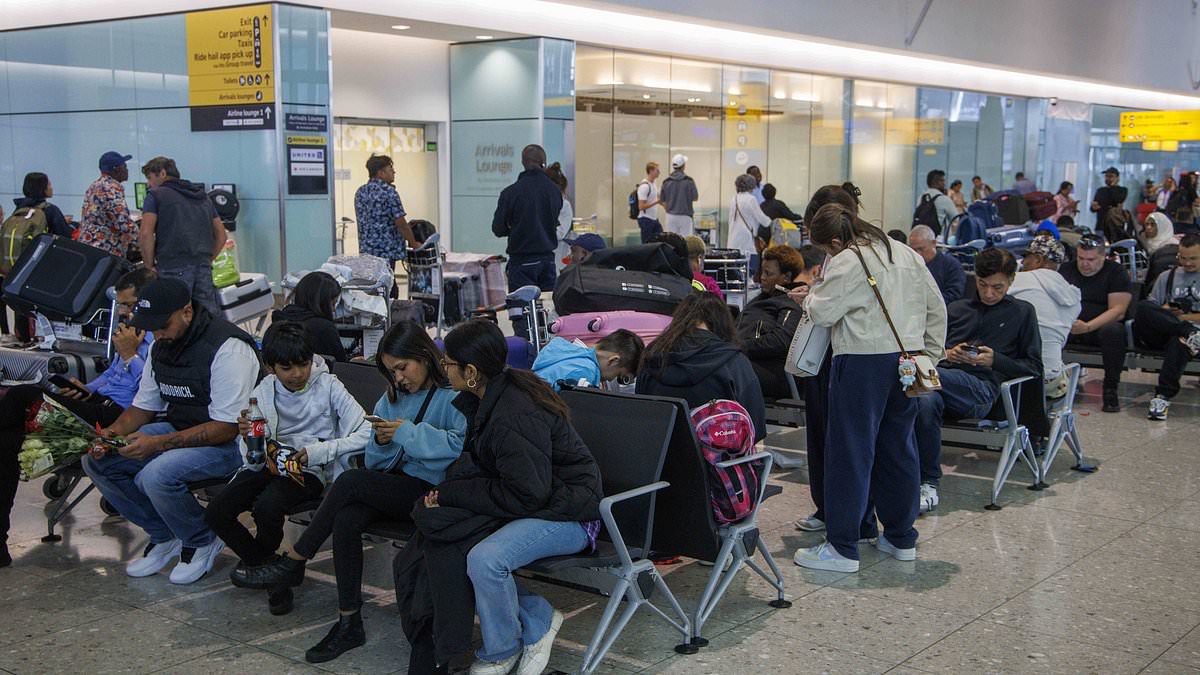Engineers were ‘on standby at home’ during the August bank holiday air traffic control meltdown and took 90 minutes to arrive on site to fix the ‘technical glitch’ which affected more than 750,000 passengers, a report has found.
Travel chaos ensued last summer after flights were grounded across UK airports on August 28 after the National Air Traffic Services (Nats) suffered a technical glitch while processing a flight plan.
More than 2,000 flights were cancelled on one of the busiest days of the year, when more than a million people were due to fly out of or land in the UK. Some travellers were also stranded overseas for several days, in what was described as the worst air traffic control incident in nearly a decade.
An interim report from an inquiry into the event found it took 90 minutes for the on-call engineer to ‘arrive on site to perform the necessary full system restart’ to resolve the issue.
It also found that many affected passengers were required to pay up front for alternative flights, food and accommodation – and submitted claims to airlines for reimbursement – despite airlines being legally required to provide these.

Families patiently wait for their flight at Heathrow following the air traffic control meltdown on August 28, 2023

Frustrated flyers waiting at Heathrow after more than 2,000 flights were cancelled on one of the busiest days of the year

Passengers were stranded overnight at Gatwick Airport after the National Air Traffic Services (Nats) suffered a technical glitch while processing a flight plan
The report, published by regulator the Civil Aviation Authority (CAA), stated that the meltdown, highlighted a ‘significant lack of pre-planning’ by those in charge.
The shutdown was caused by a single rogue flight plan, which is used by Nats to designate a plane’s journey using two ‘waypoints’ into the UK airspace.
Controllers need basic information on each flight to populate their display, such as the flight number, aircraft type, destination and route.
If these details are not spaced and formatted in a certain way, and the computer does not recognise the data, it can cause a system collapse.
This glitch which lead to the August meltdown was described by Nats’ chief executive Martin Rolfe as a ‘one in 15 million’ occurrence.
To fix the issue, it required an engineer to carry out a full system restart, ‘which was not permitted to be done remotely’, the report said.
According to the inquiry, Nats’ rostering of engineers is based ‘primarily’ on the amount of work planned.
On public holidays – when maintenance is not routinely scheduled – it is ‘common practice for staff to be available on standby at remote locations – typically at home’, meaning it took 90 minutes for the engineer to arrive on that day.
The issue was resolved at 3.15pm on Monday, August 28, but hundreds of flights had to be cancelled in the following days due to the backlog.

Tourists wait at the airport of Palma for their return flight to Italy amid the chaos

An information board reveals the extent of the cancelled flights as a result of the chaos

Passengers at Heathrow the following morning after the air traffic chaos on the bank holiday Monday

The issue was resolved at 3.15pm on Monday, August 28, but hundreds of flights had to be cancelled in the following days due to the backlog

Passengers look at information boards at Heathrow during the flight disruption
The report found that there did not appear to have been ‘any multi-agency rehearsal of the management of an incident of this nature and scale’.
These rehearsals are ‘best practice’ and ‘regularly conducted in other sectors’, the inquiry panel stated.
The interim report, published by regulator the Civil Aviation Authority (CAA), noted: ‘The panel expects to recommend that the CAA should review and lead such multiagency planning.
‘This is especially important, as some relationships between aviation sector stakeholders appear to be adversarial.
‘This is not to the benefit of passengers, especially in a crisis situation such as this incident.
‘It is clear there is a significant lack of pre-planning and co-ordination for major events and incidents that targets the alleviation and remediation of major incidents.’
Back in August, travel expert Simon Calder said but that compensation was unlikely to be offered to those affected because air traffic control faults are classified as ‘extraordinary circumstances’.
The inquiry panel found evidence of ‘misinformation about passenger rights’, with leaflets handed out by some airlines claiming passengers ‘had to make their own plans to get home’.
It said the ‘standard approach’ of informing passengers of what they are entitled to ‘is not sufficient’, and recommended the use of loudspeaker announcements and staff circulating in and around airports with ‘standardised leaflets’.
The panel described the financial cost to passengers as ‘very considerable’, but noted that the ‘stress and anxiety’ was ‘at least as serious’.

Passengers are pictured at London Heathrow Airport Terminal 5 during the chaos

Passengers were forced to sleep on the floor at Stansted Airport due to the cancellations
The inquiry was set up by the CAA and is being led by Jeff Halliwell, who has served as a chief executive and non-executive director in roles across the private and public sector.
Mr Halliwell said: ‘This interim report sets out the panel’s work so far in understanding the root causes of the incident; the effectiveness of communications between Nats, other parts of the aviation sector and the consumers; and the underpinning regulatory regime.
‘In order to produce effective recommendations, the panel has further lines of inquiry it is exploring in order to build a better understanding of how the aviation system can improve.’
CAA chief executive Rob Bishton said: ‘This interim report helps with the understanding of what went wrong, what worked well in response to this, and importantly what action can be taken to improve the UK’s aviation system for the future.’
